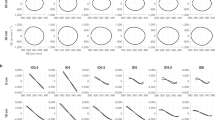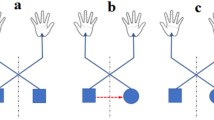Abstract
Subjects made fast, discrete elbow flexion movements while simultaneously producing rhythmical oscillations about initial and final visual targets embedded on a horizontal surface. Based on kinematic and electromyographic (EMG) analysis, we found that the discrete movement could start at any phase of the cyclical movement. The most likely onset time occurred when the first agonist burst started at the same moment as a rhythmical burst would have appeared. This resulted in a smooth conjugation between discrete and rhythmical movements. The initiation of the discrete movement was associated with the resetting of the phase of the rhythmical movements. Thus, the time characteristics of the two motor tasks were interdependent. A subset of trials with a uniform distribution of discrete movement onset phases could be selected in most subjects and was averaged to eliminate the cyclical component from the combined movement. Mean kinematic and EMG traces up until the peak velocity were practically identical to those of the discrete movement made alone. The averaging procedure was ineffective in eliminating the rhythmical component following the discrete movement because of the resetting of the phase of oscillation. Using the same procedure it has been shown that initiating the rhythmical movement at the same time as beginning the discrete movement did not affect the initial part of discrete movement. The whole discrete movement was not affected when subjects simultaneously terminated the ongoing rhythmical movements. Our findings are consistent with the hypothesis that although the rhythmical movement constrains the onset time of discrete movement, the latter, once initiated, proceeds independently of the ongoing rhythmical movement. We also subtracted the discrete component from the combined movement to see how the former affected the rhythmical movement. The residual pattern showed that the rhythmical movements rapidly attenuated when the discrete movement started and then apparently resumed after the peak velocity of the discrete movement. The results corroborate the hypothesis that the control signals underlying the two motor tasks cannot be applied simultaneously, since they may be associated with conflicting stability requirements. Instead, these control signals may be generated sequentially, but the resulting kinematic responses may outlast them and be superposed.
Similar content being viewed by others
References
Ackroyd MH (1973) Digital filters. Butterworth, London
Adamovich SV, Feldman AG (1984) Model of the central regulation of the parameters of motor trajectories. Biophysics 29:338–342
Adamovich SV, Burlachkova NI, Feldman AG (1984) Wave nature of the central process of formation of the trajectories of change in the joint angle in man. Biophysics 29:130–134
Adamovich SV, Levin MF, Feldman AG (1992) Association between rhythmical and discrete components of movements. Soc Neurosci Abstr 18:1054
Andersson O, Grillner S (1981) Peripheral control of the cat's step cycle. I. Phase dependent effects of ramp-movements of the hip during “fictive locomotion”. Acta Physiol Scand 113:89–101
Asatryan DS, Feldman AG (1965) Functional tuning of the nervous system with control of movement or maintenance of a steady posture. 1. Mechanographic analysis of the work of the joint on execution of a postural task. Biophysics 10:925–935
Berkinblit MB, Feldman AG, Fukson OI (1986) Adaptability of innate motor patterns and motor control mechanisms. Behav Brain Sci 9:585–638
Bizzi E, Accornero N, Chapple W, Hogan N (1984) Posture control and trajectory formation during arm movements. J Neurosci 4:2738–2744
Buchanan JJ, Kelso JAS (1993) Posturally induced transitions in rhythmic multijoint limb movements. Exp Brain Res 94:131–142
Deluca CJ, Mambrito B (1987) Voluntary control of motor units in human antagonist muscles: coactivation and reciprocal activation. J Neurophysiol 58:525–42
Dietz V, Quintern J, Berger W (1984) Corrective reactions to stumbling in man: functional significance of spinal and transcortical reflexes. Neurosci Lett 44:131–135
Drew T, Rossignol S (1987) A kinematic and electromyographic study of cutaneous reflexes evoked from the forelimb of unrestrained walking cats. J Neurophysiol 57:1160–1184
Feldman AG (1966) Functional tuning of the nervous system with control of movement or maintenance of a steady posture. III. Mechanographic analysis of execution by man of the simplest motor task. Biophysics 11:667–675
Feldman AG (1979) Central and reflex mechanisms of motor control (in Russian). Nauka, Moscow
Feldman AG (1980a) Superposition of motor programs. I. Rhythmic forearm movements in man. Neuroscience 5:81–90
Feldman AG (1980b) Superposition of motor programs. II. Rapid flexion of forearm in man. Neuroscience 5:91–95
Feldman AG (1993) The coactivation command for antagonist muscles involving Ib interneurons in mammalian motor control systems: an electrophysiologically testable model. Neurosci Lett 155:167–170
Feldman AG, Levin MF (1993) Control variables and related concepts in motor control. Concepts Neurosci 4:25–51
Feldman AG, Adamovich SV, Ostry DJ, Flanagan JR (1990) The origin of electromyograms — explanations based on the equilibrium point hypothesis. In: Winters JM, Woo SL-Y (eds) Multiple muscle systems. Biomechanics and movement organization. Springer, Berlin Heidelberg New York, pp 195–221
Flanagan JR, Ostry DJ, Feldman AG (1993) Control of trajectory modifications in target-directed reaching. J Mot Behav 25:140–152
Flash T (1990) The organization of human arm trajectory control. In: Winters JM, Woo SL-Y (eds) Multiple muscle systems. Biomechanics and movement organization. Springer, Berlin Heidelberg New York, pp 282–301
Forssberg H (1979) Stumbling corrective reactions: a phase-dependent compensatory reaction during locomotion. J Neurophysiol 42:936–953
Georgopoulos AP, Kalaska JF, Massey JT (1981) Spatial trajectories and reaction times of aimed movements: effects of practice, uncertainty, and change in target location. J Neurophysiol 461:725–743
Giszter SF, McIntyre J, Bizzi E (1989) Kinematic strategies and sensori-motor transformations in the wiping movements of frogs. J Neurophysiol 62:750–767
Goodman D, Kelso JAS (1983) Exploring the functional significance of physiological tremor: a biospectroscopic approach. Exp Brain Res 49:419–431
Gottlieb GL, Corcos DM, Agarwal GC (1989) Strategies for the control of voluntary movements with one mechanical degree of freedom. Behav Brain Sci 12:189–210
Grillner S (1985) Central pattern generators for locomotion, with special reference to vertebrates. Annu Rev Neurosci 8:233–261
Hasan Z (1986) Optimized movement trajectories and joint stiffness in unperturbed, inertially loaded movements. Biol Cybern 53:372–382
Hogan N (1984) An organizing principle for a class of voluntary movements. J Neurosci 4:2745–2754
Humphrey DR, Reed DJ (1983) Separate cortical systems for control of joint movement and joint stiffness: reciprocal activation and coactivation of antagonist muscles. Adv Neurol 39:347–72
Katayama T, Kohase H, Nakamura Y (1993) Resetting of cortically induced rhythmical jaw movements by stimulation of the cerebellar interpositus nucleus in the guinea pig. Brain Res 617:143–146
Keder-Stepanova IA (1967) The characteristics of respiratory neurons at different levels of the central nervous system. In: Models of structural-functional organization of some biological systems. MIT, Boston pp 95–105
Kelso JAS, Southard DL, Goodman D (1979) On the nature of human interlimb coordination. Science 203:1029–1031
Lacquaniti F (1992) Automatic control of limb movement and posture. Curr Opin Neurobiol 2:807–814
Lan N, Crago PE (1992) Equilibrium-point hypothesis, minimum effort strategy and the triphasic muscle activation pattern. Behav Brain Sci 15:769
Latash ML (1993) Control of human movement. Human Kinetics, Champaign, IL
Latash ML, Gottlieb GL (1991) Reconstruction of joint compliant characteristics during fast and slow movements. Neuroscience 43:697–712
Latash ML, Gutman SR, Gottlieb GL (1991) Relativistic effects in single-joint voluntary movements. Biol Cybern 65:401–406
Levin MF, Feldman AG, Milner TE, Lamarre Y (1992) Reciprocal and coactivation commands for fast wrist movements. Exp Brain Res 89:669–677
Milner TE, Ijaz MM (1990) The effect of accuracy constraints on three-dimensional movement kinematics. Neuroscience 35:365–374
Nagasaki H (1992) Asymmetrical trajectory formation in cyclic forearm movements in man. Exp Brain Res 87:653–661
Parush A, Ostry DJ (1993) Lower pharyngeal wall movement in speech. J Acoust Soc Am 94:715–722
Sergio EL, Ostry DJ (1993) Three-dimensional kinematic analysis of frog hindlimb movement in reflex wiping. Exp Brain Res 94:53–64
Staude G, Wolf W, Wierzbicka MM, Dengler R (1992) Tremor as a factor in delayed reaction time. Soc Neurosci Abstr 18:862
Stein RB (1982) What muscle variable(s) does the nervous system control in limb movements? Behav Brain Sci 5:535–577
Stein PSG, Johnstone KM (1986) Motor patterns during rostal scratching and forward swimming in the turtle. Soc Neurosci Abstr 12:790
Stein PSG, Camp AW, Robertson GA, Mortin LI (1986) Blends of rostral and caudal scratch reflex motor patterns elicited by stimulation of two sites in the spinal turtle. J Neurosci 6:2259–2266
St-Onge N, Qi H, Feldman AG (1993) The patterns of control signals underlying elbow joint movements in humans. Neurosci Lett 164:171–174
Viviani P, Terzuolo C (1982) Trajectory determines movement dynamics. Neuroscience 7:431–437
Author information
Authors and Affiliations
Rights and permissions
About this article
Cite this article
Adamovich, S.V., Levin, M.F. & Feldman, A.G. Merging different motor patterns: Coordination between rhythmical and discrete single-joint movements. Exp Brain Res 99, 325–337 (1994). https://doi.org/10.1007/BF00239599
Received:
Accepted:
Issue Date:
DOI: https://doi.org/10.1007/BF00239599




